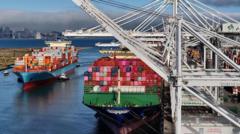The ongoing U.S.-China trade conflict has evolved into a struggle over global supply chains, with both nations restricting access to critical technologies and materials. Recent actions include the U.S. halting sales of semiconductor components to China, while Beijing limited exports of essential minerals. This strategic maneuvering threatens industries that depend on a collaborative supply chain, particularly the aviation sector.
U.S.-China Supply Chain Conflict Escalates: The New Frontier of Trade Warfare

U.S.-China Supply Chain Conflict Escalates: The New Frontier of Trade Warfare
As the U.S.-China trade tensions deepen, both nations are shifting their focus from tariffs to supply chains, raising concerns for various industries reliant on mutual cooperation.
The trade battle between the United States and China is undergoing a significant transformation, shifting its nature from traditional tariff disputes to a more complex confrontation centered on global supply chains. As both nations impose restrictions on the sharing of essential technologies, this new phase of trade warfare could have profound implications across various industries that heavily depend on these vital resources.
Recently, the U.S. government announced a suspension of some sales to China concerning key components and software for jet engines and semiconductors. This decision emerged as a countermeasure to China’s recent restrictions on the export of crucial minerals used in numerous manufacturing processes, indicating a tit-for-tat scenario developing between the two powers. Such actions have led both countries to accuse each other of insincerity and detrimental trade practices.
The evolving nature of this supply chain conflict is particularly worrying for businesses that intertwine their operations with components sourced from both nations. With the backdrop of previously imposed tariffs, companies are expressing deep concerns about their ability to manufacture products, given the growing restrictions in place.
The aviation industry exemplifies the intricate dance of dependency and weaponization in this trade struggle. The U.S. remains home to advanced jet engine technologies developed by leading firms such as General Electric. However, to bolster its own aviation sector in competition with major players like Boeing, China has had to acquire vital engine tech from American firms. Conversely, many critical components necessary for engine performance come from rare earth minerals processed primarily in China. This dual reliance underscores the complexities of the current trade standoff.
In April, as the U.S. heightened tariffs on Chinese goods, Beijing responded by tightening the export of these rare earth minerals, marking a significant escalation in the trade war. This pivot to leveraging supply chains as a weapons system illustrates a broader strategic competition that, if left unchecked, could undermine various sectors, from pharmaceuticals to shipping, making the stakes incredibly high for both nations and their economies.





















